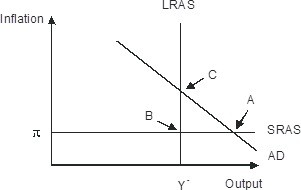An income transfer contains less fiscal stimulus than an increase in government spending of the same size.
Answer the following statement true (T) or false (F)
True
When government spending increases, the initial spending injection will be equal to the change in spending. Only part of an initial income transfer is used to increase consumption; the remainder is saved. Accordingly, the initial spending injection is less than the change in income transfers. This makes transfer payments less stimulative than government purchases of equal size.
You might also like to view...
Refer to the figure below. In response to gradually falling inflation, this economy will eventually move from its short-run equilibrium to its long-run equilibrium. Graphically, this would be seen as 
A. long-run aggregate supply shifting leftward B. Short-run aggregate supply shifting upward C. Short-run aggregate supply shifting downward D. Aggregate demand shifting leftward
Does it matter how much a developing country saves? Explain why or why not. Discuss theories and evidence on whether developing countries can increase the net savings rate in the economy through public policy
In particular, consider whether this can be accomplished through increased or decreased taxation of one or more types, and increased or decreased government spending of one or more types.
The demand for current consumption, as plotted against current income, shifts to the right due to all of the following except
A) a decrease in current taxes. B) a decrease in future taxes. C) an increase in current income. D) an increase in future income.
Which of the following is the best example of a microeconomic topic?
A. The impact that the money supply has on inflation. B. The reasons for increases in the price of soft drinks. C. The effect that federal budget deficits have on the interest rate. D. The tradeoff between inflation and unemployment.